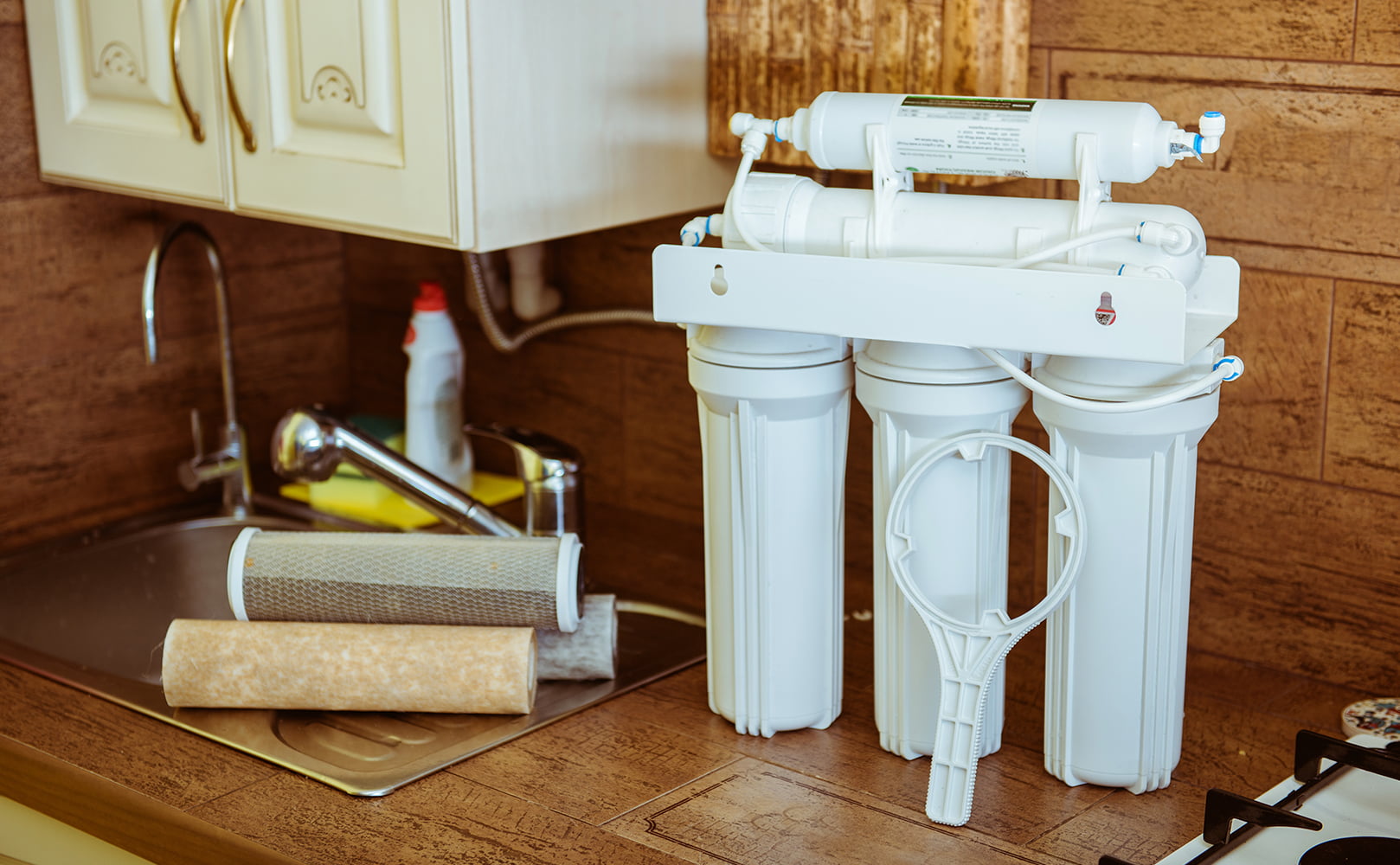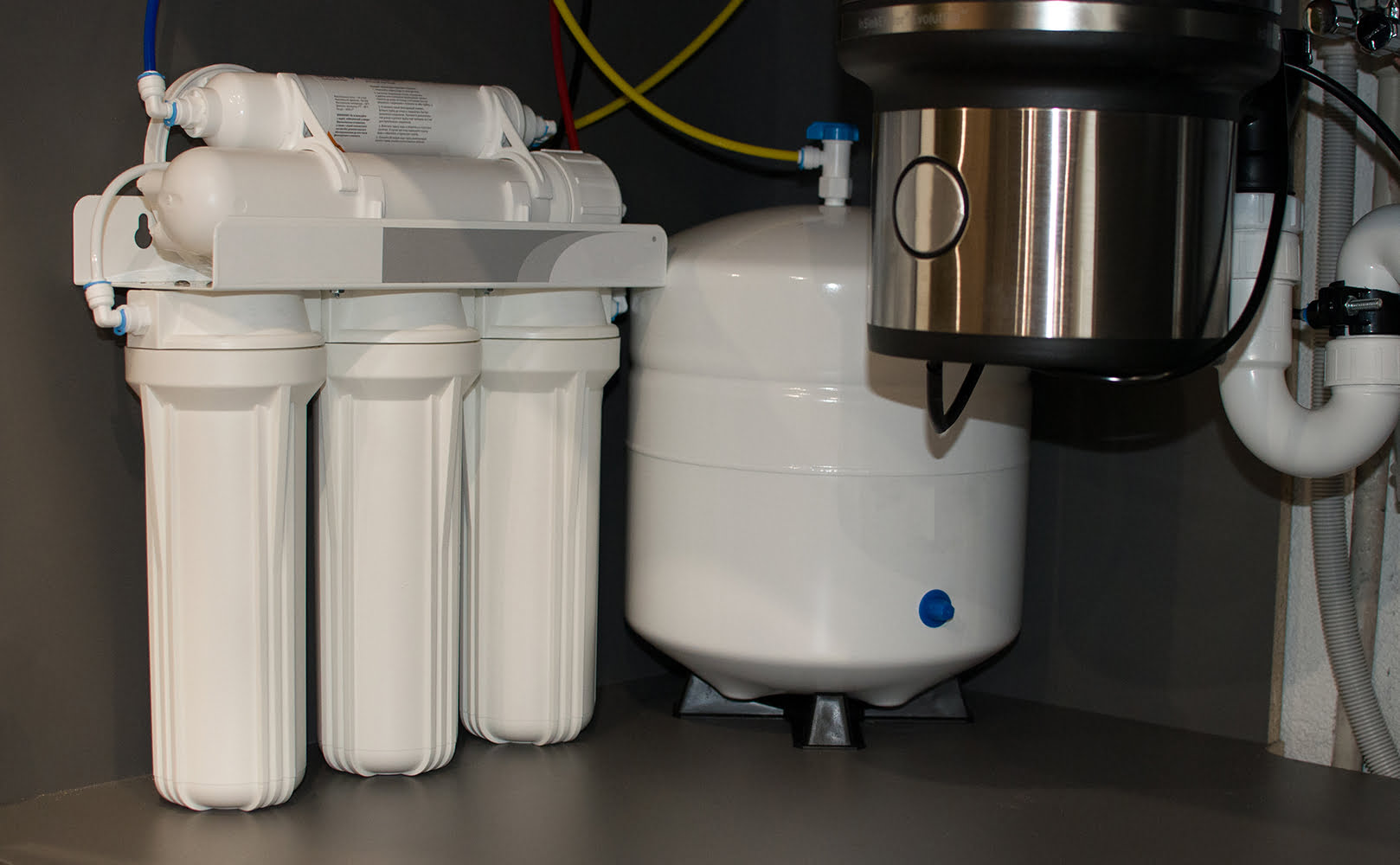Under Sink Water Filter Types – The Complete List
Written by: Gene Fitzgerald // Last Updated: Sep 4, 2023
This page may contain affiliate links. If you buy a product or service through such a link we earn a commission at no extra cost to you. Learn more.
Under sink water filters are convenient units that work for removing a variety of impurities from water while being affordable and easy to maintain.
Moreover, if you purchase an under sink water filter system it will last you a long time, making it a cost-effective choice compared to bottled water. Also, it will fit effortlessly under your kitchen sink, so you don’t have to create any extra space on your countertop.
However, if you’re purchasing one for the first time, the wide range of products can be confusing.
Here, we’ve described the various types of under sink water filters to help you make the right decision when shopping.
Key Takeaways
These are the different under sink water filter types:
- Sediment filters – for large, floating particles
- Activated carbon filters – for various contaminant types (chemicals, heavy metals, etc.)
- Catalytic carbon filters – great for chloramine
- KDF filters – for chlorine and certain heavy metals
- Iron and other oxidation filters – for iron, manganese, sulfur
- Ion exchange filters – for inorganic substances
- Activated alumina filters – for fluoride and arsenic
- Reverse osmosis systems – for broad contaminant removal
- UV water purifiers – for microorganisms
- Single-stage or multi-stage under sink water filters
- Inline filter or with dedicated faucet
What Is an Under Sink Water Filter?
An under sink water filter is simply a water purification unit designed to be placed under your kitchen or bathroom sink. These filters comprise one or more filtration stages and remove various impurities and contaminants from the water you use in your home.
Most commonly, the filter media used in under sink water filters is activated carbon. Besides that, many systems use sediment filter cartridges, ion exchange resin, reverse osmosis membranes, KDF, catalytic carbon…
While some homes only require basic filters like carbon and sediment, others might need a more advanced filtration process to improve water quality.
With their wide range of filter media, under sink water filters can target many different contaminants such as chlorine, lead and other heavy metals, fluoride, and PFAS.
The Different Types of Under Sink Water Filters and How They Work
As mentioned, there are multiple types of under sink water filters to choose from. Each unit can be classified based on the filter medium it uses and the contaminants removed during the filtration process.
Other differentiating factors include the price range and installation + maintenance requirements.
If you’re thinking of investing in an under sink water filer, this description of each type will help you out.
Single-Stage Under Sink Water Filters
Single-stage under sink water filters are the ones that use only one type of filter media to purify water. Although these units can be highly effective at what they do, their functionality depends on the filter medium used.
Whichever single-stage system you choose for your home, you can get it at an affordable price with minimal installation hassle.
The primary filter media and methods used in single-stage under sink water filters include:
Sediment Filters
Sediment filters are among the most commonly used in single-stage water filter systems. If the water in your location contains dirt, sediments, and other solid particles, these filters will easily remove them.
There are three types of sediment filters: Surface, depth, and absorptive filters.
While all three tackle a broad spectrum of floating particles, they are ineffective against chemicals, salts, and other suspended contaminants and impurities.
Granular Activated Carbon
This is a more advanced filtration method used in single-stage under sink water filters. Constructed with highly absorbent porous material, granular activated carbon combines chemical reactions with adsorption to clean water.
Besides removing a wide range of chemicals like pesticides and disinfection byproducts, carbon filters also remove bad taste and odor. Another benefit is that they allow high flow rates.
Carbon Block Filters
These filters are constructed by gluing very fine powdered carbon together to form an emulsion. Further, the mixture is pressed into cartridges to filter your water supply.
With a micron rating of around 0.5-10, many carbon block filters can even remove bacteria and cysts.
Catalytic Carbon Filter Cartridges
Another carbon-based water filter medium, catalytic carbon, is ideal for removing more stubborn chemicals from your drinking water. While typically activated carbon filters are not efficient at removing chloramine, these filters can easily do the job.
So if you’re purchasing a single-stage filter but are concerned about disinfection chemicals in your water supply, make sure to get one with these.
KDF Filter Cartridges
KDF filter cartridges use redox reactions to remove water pollutants.
KDF consists of a copper-zinc blend that can remove stuff like chlorine, lead, chromium, mercury, and hydrogen sulfide.
Moreover, these cartridges also hinder bacteria and other microbes from accumulating in the filtering system.
Quite often, KDF filters are used in multi-stage under sink filtration systems to reinforce carbon filters.
Iron Filters
Similarly, iron filters are also often included in multi-stage under sink filters to remove ferrous from water.
They do so by converting soluble iron into rust which gets trapped in the filter media.
Ion Exchange
Ion exchange is another effective treatment method used in many different types of home water filters.
The ion exchange resin targets very specific contaminants; therefore, it’s helpful for households who need such functionality due to their special water conditions.
Most ion exchange filters work to remove inorganic substances like arsenic and sulfate.
Activated Alumina
For those who want to target elements like uranium and thallium, arsenic, and fluoride, an activated alumina filter makes a great choice.
Pros
- Affordable price
- Easy installation
- Low maintenance cost
- Accessible repairs
Cons
- Limited filtration ability
Multi-Stage Under Sink Water Filters
As the name suggests, multi-stage under sink water filters use 2 or more filter stages to treat water.
Most often, multi-stage under sink water filter systems use sediment filter cartridges at the beginning of their filtration process. This is usually followed by some sort of activated carbon for improving water aesthetics.
UV Filters
Ultraviolet filter cartridges are featured in some under sink water filters. They contain a UV light bulb.
This bulb emits UV rays that inactivate harmful microorganisms like bacteria – the UV rays destroy the DNA of microbes so they can’t reproduce in the water and harm the people drinking it.
Pros
- Combination of filtration methods
- Can remove a vast spectrum of water contaminants
- Ensure safe drinking water in any location
Cons
- Possibly reduced water flow
- Costly maintenance
- More difficult installation
Reverse Osmosis Systems
Reverse osmosis systems are among the most advanced and effective water filters for home use. Most are designed to fit under the sink, which is why we include them in this article.
However, RO systems are slightly different from conventional under sink water filters. First, they sport a pressurized water tank, some even a pressure pump. Moreover, they always come with their own faucet.
Most importantly, RO systems require a drain connection as well. That’s because they produce wastewater which you’ll need to get rid of.
How about filtration effectiveness? A reverse osmosis system removes about every water contaminant and impurity. These units can target particles as tiny as a thousandth of a micron.
This means whether your water is contaminated with chemicals, tannins, pesticides, heavy metals, microbes – you name it – reverse osmosis water purification can remove it.
Pros
- Ideal for severe water contamination
- Great at improving the overall quality of water
- RO membrane does not require frequent replacement
Cons
- Can be more expensive to buy and maintain
- Some people describe water taste as flat
Inline Filter or Dedicated Faucet
Apart from single-stage and multi-stage filters, under sink systems can feature an inline design or use a dedicated faucet.
First, let’s talk about inline filters. As named, these filters are installed in continuation with the existing cold water line in your kitchen. The filter activates when you open the sink faucet, and the water filters through the system before flowing out of the tap as usual.
On the other hand, dedicated-faucet water filters come with an extra dispenser. Some also have a storage tank.
How Long Do Under-the-Sink Water Filters Last?
How long your under sink water filter lasts depends entirely on the type you purchase and the use you put it through. The filter comes with instructions regarding when the cartridges will need to be changed.
Typically, you’ll need to replace filter cartridges annually or biannually. However, if the water in your area is very hard or has high levels of sediments, you should replace the cartridges more frequently.
Although you can hire a professional plumber to do this, you can easily complete the task yourself as well.
- Start by closing the water supply and draining the remaining water.
- Then, remove the filter housings and throw away the old cartridges.
- Next, insert the new cartridges after cleaning the housings and check the water flow.
Changing filter cartridges and membranes on time will guarantee steady water quality and makes sure your under sink water filter lasts you long-term.
Are Under Sink Water Filters Worth It?
Yes, under sink water filters are worth investing in. They are affordable and easy enough to install to do the job yourself. But even if you hire a professional, you won’t be paying a fortunate.
The best part is that you don’t need to change your kitchen decor. Instead, you can fit the filter under your sink so it stays concealed without taking up any extra space.
Once your under sink filter system is installed, you’ll only spend on annual or biannual cartridge replacements. This means you’ll only pay a fraction of what you would if you used bottled water.
Besides that, if you carefully invest in a high-quality unit, it will last you for years to come. Not to mention the medical bills you will save up on by ensuring clean and safe drinking water for your family.
While an RO system or high-end multi-stage under sink water filter might seem expensive at first glance, it is an economic decision if you keep the future in mind.
If you have any questions about the different types of under sink water filters please don’t hesitate to leave a comment below!
Information provided on BOS is for educational purposes only. The products and services we review may not be right for your individual circumstances.
We adhere to strict editorial guidelines. Rest assured, the opinions expressed have not been provided, reviewed, or otherwise endorsed by our partners – they are unbiased, independent, and the author’s alone. Our licensed experts fact-check all content for accuracy. It is accurate as of the date posted and to the best of our knowledge.



